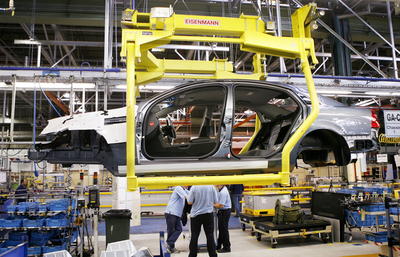While the momentum of reform weakened in the early years of the 21st century, and productivity growth petered out, the externally-funded housing and consumption boom that kept the economy rolling forward was followed by an enormous lift in Australia’s terms of trade. This, with some help along the way from the large stimulus in response to the global financial crash of 2008, has sustained strong growth ever since.
The resources boom, driven by the metals and energy intensity of China’s remarkably high rate of growth, lifted Australian iron ore and coal prices to historical highs, raising the real exchange rate to unusually high, and unprecedented, levels. The accompanying resource investment boom and capital inflows added to the cost-raising, expansionary pressures as the Chinese economy was steered quickly through the crash of 2008. China’s fiscal and monetary expansion lifted iron ore and coal prices back on a strongly rising trajectory in the second half of 2009, and their prices rose to new heights in 2010 and 2011.
The Australian minerals boom has peaked, as commodity prices eased back after 2011, and investment has begun to taper. While the Chinese economy is still growing much more rapidly than many anticipated, it has entered a new, more moderate growth phase and the structure of growth is shifting to a pattern that is less resource intensive. While the growth rate of Chinese resource imports, in particular iron ore, is slowing, this does not mean that Australian iron ore exports to China won’t continue to grow in volume and their share of Chinese iron ore imports increase. But the price at which they are delivered will be lower, and investment to expand mining capacity is coming to an end.
The consensus that Australia needs to prepare for a major economic adjustment and commit to restitution of a new round of productivity-enhancing reforms to allay the impact of these changes in its external economic circumstance on incomes and income growth has been significantly shaped by Ross Garnaut, author of this week’s lead essay which looks at challenges faced by the Australian economy in the years immediately ahead.
Garnaut argues that, going forward, ‘the maintenance of high employment and reasonable output growth without external payments problems requires the restoration of investment and output in trade-exposed industries beyond resources’. This argument was elaborated in the Gillard government’s Australia in the Asian Century White Paper, which also set out a raft of economic and social reforms that would be necessary to deliver that. It is not, as Garnaut reminds us, that there are not many opportunities for Australian business in China and the rest of Asia around the change of direction in growth, but the policy environment will need to be focused more sharply towards improving productivity and competitiveness.
Yet, Garnaut observes, ‘the real exchange rate by early 2013 was at levels that rendered uncompetitive virtually all internationally traded economic activity outside the great mines. A substantial reduction in Australian cost levels relative to other countries is required — a large depreciation of the real exchange rate — to maintain employment and economic growth’.
‘The more that productivity growth can be increased the better. Helpful policy measures include the removal of artificial sources of economic distance between Australia and its rapidly growing Asian neighbours to allow larger gains from trade — removal of remaining protection and industry assistance at the border as the real exchange rate falls, and investment in transport and communications infrastructure’.
The nominal (and the real) exchange rate is now of course depreciating quite rapidly. Australia’s floating exchange rate — on the introduction of which 30 years ago last October Garnaut was such a key adviser to then Prime Minister Bob Hawke and Treasurer Paul Keating — has been an extremely effective mechanism for managing the adjustment to major external shocks, such as the Asian financial crisis and the recent commodities boom. In the resources boom, the exchange rate appreciation drove down costs (of a whole range of importable goods like white goods, cars and basic consumer products) to households and businesses and delivered substantial income gains across the community via that mechanism. While the states and commonwealth government reaped large tax revenues and the community benefited (rather too fulsomely Garnaut and many others would argue) from tax cuts and higher public expenditures, direct gains were distributed via the exchange rate adjustment. Unless the macro-economic policy settings and institutions — for example strong, independent central banking and fiscal discipline — are messed with, there’s every reason why the effective flexibility of the Australian dollar will help see Australia through the slump in its terms of trade which Garnaut now foretells.
Garnaut’s central message is that, on past performance, Australian governments need to be reminded that the disciplines and reforms now required will be essential to convert a large nominal depreciation of the Australian dollar into a real depreciation and that ‘requires social cohesion around acceptance that all elements in society must share in restraint as well as commitment to productivity-raising structural change’. He worries, as well he might, that achievement of this outcome might be frustrated by changes in the political culture of Australia since the earlier reform era, as the ‘uninhibited pursuit of private interests has become much more important in policy discussion and influence’.
Among the many policies that Australia needs to get right, Luke Hurst argues in a related piece, is its foreign investment policy. A robustly open foreign investment regime is important to navigating the bad luck of the downturn in commodity prices, not only for the minerals sector but in agriculture, services and manufacturing where links to the international market are increasingly critical to lifting competitiveness and productivity. The recent signals from investment policy decisions do not bode well for the overall task.
Peter Drysdale is Editor of the East Asia Forum.

